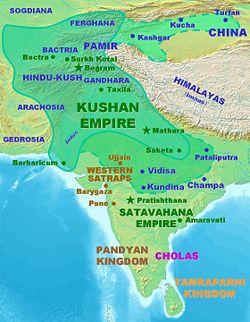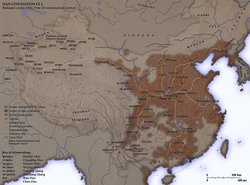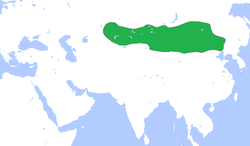Background for the 2008 game by
Decision
Factions:
Blue ·
Red ·
Green ·
Purple
Qi
Established c. 1046 BC, it was one of the seven Warring
States and had its capital in Shandong. Originally just a state in the
Zhou Dynasty, it came to be ruled by the Jiang family for several
centuries until they were displaced by members of the Tian family in
384 BC.
included areas in Henan, Hebei, Shanxi and Shandong. This
state concentrated on irrigation projects on the Yellow River.
Ignoring the threat from the Qin to its west, the Wei focused on
conquest to the east, but was defeated several times. Meanwhile Qin
reformations boosted their economy and conquered Wei's western
regions to the extent that the capital was moved further east. Wei
allied itself with the Han, but the Qin defeated their army at the
Battle of Yique in 293 BC. In 225 BC the Wei surrendered to the Qin
completely after they flooded new capital by diverting the Yellow
River. Although it held out for a long time, like the other Warring
States it eventually succumbed to the Qin, being the last to do so in
221 BC.
Kushans

Kushan empire. Neighboring
territories are tributary; in the game
top right is part of Xinjiang
|
The Kushans were an Indo-European speaking tribe
called in Chinese chronicles the Yuezhi.
Their own name for this latter group may have been the Visha and this
was the closest that Chinese writing could achieve. These Visha were
living in what are now Xinjiang and Gansu until they lost out in
conflicts with the Mongolian Xiong Nu (in the game called Huns)
during 176-160 BC and decided to move west
to Bactria where they dislodged Sakas or Scythians, probably also an
Indo-European people, who had earlier dislodged the Parthians and
Bactrian Greeks who had been set up there by Alexander the Great.
Here the Kushan tribe of the Visha set up one of the four great
empires of the period (the others being the Roman, the Parthian and
the Han). Most of the Kushan holdings were in Central Asia and
northern India, but they also controlled the desert oases of Xinjiang,
probably as a way of controlling the lucrative trade in silk and
other items carried by Sogdians and passing through these areas.
Han

Han Dynasty holdings in dark brown
|
The Han Dynasty was the second imperial dynasty of China after the
Qin and is considered a golden age in China. Beginning about 206 BC,
it continued in two periods known as the Western Han to 9 AD and then
the Eastern Han to 220 AD. The dynasty's founder was the peasant rebel
leader Liu Bang, later known as Emperor Gaozu who was able to
establish authority in the instability after the death of the Qin
founder. Han territories were mostly concentrated in the north and
east, but did reach to the Tarim basin in Xinjiang. Areas of the
coast opposite Taiwan and some areas in the southwest east of Yunnan were
never under control, however. Besides
rebellion, their primary antagonists were the Xiong Nu (Huns)
who eventually came to control Manchuria, Mongolia, the Tarim basin
and points west such as Samarkand. The Han established a trade embargo
on weapons and in revenge the Huns invaded Shanxi, after which the Han
were forced to pay large amounts of tribute to maintain peace. Control
seesawed back and forth between the Han and Huns, who sometimes had
the Qiang as allies. When the Han had reached a moment of triumph,
they defeated the Nanyue at sea and expanded control into Guangdong,
Guangxi and northern Vietnam. Yunnan and northern Korea were also
conquered. After 9 AD there was an interregnum due to the successful
revolution of Wang Mang and control of the Tarim basin, Korea and
Vietnam were lost and the Huns resumed their raids. Eventually the Han
chased them across the Altai Mountains, upon which the nomadic
Xianbei took the opportunity to occupy the north from the coast all
the way to Xinjiang and beyond. Over time generals were able to amass
personal loyalties and sought to take power for themselves. This led
to many successful rebellions and loss of power for the the emperor.
Eventually China was divided into three spheres of influence which
became the Three Dynasties: the Cao Wei (in the game Wei), the Eastern Wu
(Wu) and the Shu Han (Shu).
Tungus

Tungus dominance in blue;
Song Dynasty is orange;
Xi Xia in green
|
The term Tungus, a designation spread by Russians who got it from the
Yakuts and Tatars, has today been largely supplanted by the indigenous
term Evenks, for a people of Siberia.
In the game, they first appear at at time when this group wasn't
particularly making any history. However, one of their tribes
called the Jurchen, the Jin, the Kin or several other names
was founded in Manchuria in 1115 and by 1125 it had destroyed
the Liao Dynasty which had previously controlled Manchuria and part
of the Mongol region. In 1127 they ransacked the capital of the Song
Dynasty and captured the emperor. War continued until 1141 and
ultimately the northern part of the Song territory was ceded to
them. After this the Jurchen became sinicized and the capital was
eventually moved south from the city near Harbin to Beijing. Attacks
on the Song resumed in 1161, but two revolts broke out in the north at
the same time, one by Khitan tribesmen. Much weakened, the Jurchen
ultimately fell to the Mongols.
Their descendants became the Manchus, known as the Qing dynasty in
the game.
16 Kingdoms
Also known as the Sixteen States, various states in existence from
304 to 439 AD. None of these states could consolidate power for long.
By name they were the
Han Zhao, Later Zhao, Cheng Han, Former Liang, Later Liang,
Northern Liang, Western Li�ng, Southern Liang, Former Yan, Later Yan,
Northern Yan, Southern Yan, Former Qin, Later Qin and Western Qin and Xia.
Almost all of the rulers of these states were not Chinese, but from
the Wu Hu tribe, northern nomads. These nomads, led to revolt by
the Xiong Nu (Huns in the game), overthrew the Jin Dynasty and
drove them out of northern China. Eventually these were all defeated
and most of China reclaimed. In the north, control was held by the
Xianbei Northern Wei.
Rouran

Rouran dominance in green
|
Also known as the Juan-Juan and by many other names,
this was a nomadic confederation
of mostly Xianbei people who remained in Mongolia even after
the Xianbei set up kingdoms in northern China. In the fifth century
they controlled Mongolia west to Turpan, which in the game is in Xinjiang.
China, following a divide and conquer policy used encouraged
divisions among them and in 508 they were defeated by the Tiele.
They got their revenge in 516 however and defeated the Tiele.
But one of their tribes, the Tujue, defected to the Western Wei
and defeated them in 555. Rouran power was destroyed. Many were killed,
some fled west, others into China.
10 Kingdoms

Some of the divisions in
the 10 Kingdoms period
|
By the ninth century the Tang Dynasty had become so
weak at that time that all it could do was okay the fait accompli
takeovers of various warlords. In 907 the last Tang emperor
was forced to abdicate and a series of more than twelve independent
states were established, though only ten are normally listed:
Wu, Wuyue, Min, Chu, Southern Han, Former Shu, Later Shu, Jingnan,
Southern Tang, Northern Han. They quickly succeeded one another and
by 960 the Song Dynasty had been founded and controlled most of
their territories.
Song

Song territories at their height
|
Succeeding the Ten Kingdoms period, they are called the Northern
Song with capital in Kaifeng in the period 960-1127. The following
period until 1279 when the northern areas were lost and the capital
removed to south of the Yangtze is called Southern Song. This was
the first government in the world to issue paper money, the first
Chinese dynasty to establish a permanent navy and the first to
understand the compass. They were also the first to regularly employ
gunpowder for military uses. Due to expanded rice cultivation and
the use of early-ripening rice, the population doubled under their
aegis. The government also reduced the typical heavy control of markets and
the economy.
The spread of literature and knowledge was enhanced by the 11th-century
invention of movable type printing. Pre-modern technology, science,
philosophy, mathematics, engineering, and other intellectual
pursuits flourished.
Power and influence shifted from the aristocratic elite to the
bureaucratic elite. Emperor Taizu, the founder, unified China by
gradually conquering all other rivals. He stabilized the empire by
instituting civil service exams. Rivals for power were the Khitans
and the Tanguts. Relations alternated between war and diplomacy.
When defeated and forced to pay tribute, such was the strength of
the Song economy and foreign demand for their products that it had
little negative effect. An inconclusive
war was also fought with the Ly Dynasty of Vietnam.
Eventually the Jurchen captured the Song capital in the north and
the empire relocated south. Though weakened, the economy was still
relatively strong and the Song were able to strengthen it yet
further. They developed gunpowder bombs and paddle wheel ships
that permitted two naval victories on the Yangtze
over Jurchen forces over twenty times larger. However, in the 1270s
they were unable to stop Kublai Khan and the Mongols who as the Yuan
became China's next ruling dynasty.
French
After the Napoleonic Wars ended in 1815 world trade increased
rapidly and the great powers looked at China as a huge market for
their goods. However, the Qing dynasty forced all payments for
Chinese products to be in silver. France and Britain needed Chinese
silk, tea and ceramics, but didn't have enough silver to pay.
As a consequence, they got China addicted to opium. By illegally
selling this to Chinese they eventually earned back enough silver
to buy the next installments of goods they wanted. The emperor
attempted to ban trading in opium in 1838 and Britain declared war.
During the First Opium War the Chinese were completely outclassed
and forced to surrender. The resulting of treat gave Europeans
unrestrained access to Chinese ports (and founded Hong Kong island
as a British trade emporium).
Two Chinese rebellions, the Taiping and the Nien, followed.
The powers helped only grudgingly and Britain pressed for more
concessions. When the Qing refused, they were defeated by a
combination of the French and British in the Second Opium War.
The French concession in Shanghai was established in 1849 and gradually
expanded, lasting until 1943. They were also granted a permanent
diplomatic presence in Beijing. They developed a considerable sphere
of influence in south China, adjacent to their holdings in Vietnam.
Germans
Late to the game of empire, Germany gained control of the coastal
port of Qingdao in Shandong via a 99-year lease.
There they created a facisimile of a German port city in miniature.
Two years later this was also the site of the beginning of the
Boxer Rebellion, a revolt of the people against foreign powers with
late support by the emperor. The great power legations were besieged
by the Boxers in Beijing. It required two interventions to relieve
them, it finally being accomplished by an eight-power force
generalled by the German Alfred Graf von Waldersee. Reparations
were paid by China in the amount of $450 million:
Russia got 30%, Germany 20%, France 15.75%, Britain 11.25%,
Japan 7.7% and the USA 7%. Germany stationed its Far East squadron
at Qingdao and developed the city considerably, building streets,
installing electricity and a safe water supply. They also
created the world famous Tsingtao Brewery. With the outbreak of
World War I, Japanese forces fighting on the side of the Entente
besieged Qingdao and eventually claimed it, thought it was no
restored to China until 1922.
Communists

The Long March
|
Communism in China had its first faint beginnings in 1919. The party
was founded in 1921 in Shanghai. Mao Zedong was present at the first
congress in 1921 as one of two delegates from Hunan. Before long a
military force was developed which worked with Chiang Kai-shek's
Kuomintang to overthrow various warlords. However the two sides
broke ranks in 1927 as Chiang attempt to consolidate power. The
communists had to give up their bases in 1934-5 and complete the
Long March to find new bases in more remote Shensi. During this time Mao
and others gained power. When Japan invaded in 1937, an
accommodation was made with the KMT to fight the common enemy, but
not a joint command. Both sides maintained their independence.
After 1945 civil war resumed, the KMT eventually being defeated and
forced to flee to Taiwan. The People's Republic of China was
established October 1, 1949.
June 22, 2011.
Created October 1, 2009
spotlightongames.com






